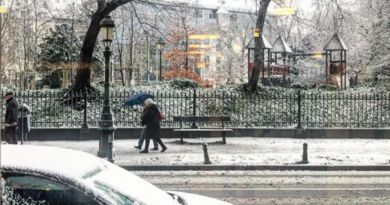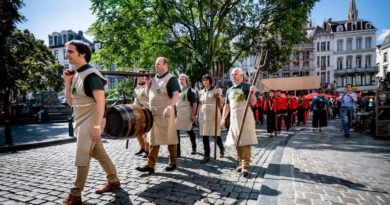Sweating for Europe
“Seeing the results from the first round of elections last Sunday in France, the discourse that we have about Europe these days is very important,” says Jean-Claude Crespy, director at the Alliance Française in Brussels. Behind him stands an old firetruck converted into a sauna, just a few meters away from the Place de Luxembourg roundabout; there are woods burning in the furnace, getting the temperature to rise inside the sauna on this windy April day. Ahead of Mr. Crespy is the European Parliament.
The truck-sauna was created by the German artist Dida Zende and is part of a three-day initiative called Sweating for Europe, organized by the Finnish Cultural Institute, the Goethe Institute and the Alliance Française. Since Monday, the sauna and the Parliamentarium have been the setting for informal conversations between MEP’s and the people in Brussels.
“We want to build trust,” said Aleksi Malmberg, director at the Finnish Cultural Institute. “And we feel that going into the sauna could do just that. Specially now.”
The sauna is at the heart of the Finnish Culture. In the past, the first thing that one used to build was the sauna, then came the rest of the house. It was also the place where women gave birth, where people with illnesses came to heal. It was also where people’s bodies were cleaned when they passed away.
Yesterday evening some MEPs went into the sauna and held conversations with a moderator and the artist before meeting an audience at the Parliamentarium.
“We almost had to pull them out to come to the talk,” said Malmberg, jokingly. “They were enjoying it so much.”
Gathered around Mr. Malmberg there is a group of journalists, getting ready to go into the sauna and feel the experience. It was windy and overcast, and so we get changed, then hurry into the sauna, where it’s warmer. A lot warmer. Mr. Malmberg was in charge, he poured water over the heated rocks and the temperature raised almost instantly.
Inside, there was in total nine people: three women and six men. Seated on the wood benches, we talked about sauna and hammam and their effects on blood circulation. In the center lied a washbowl with a handful of tied birch branches in it, their scent filling the room. Through the window we could peer at the people walking in and out of the Parliament, the soldiers guarding the entrance. There was a tree too, its branches swaying softly in the wind.
“How did the German press take the results from the elections on Sunday?” asked Corinne Pelé, cultural coordinator at the Alliance Française. Christine Nord, director of cultural programming at the Goethe Institute, ponders the question for a moment, then begins to share her thoughts. The conversation turned to politics.
A few minutes later we exit the cabin and the team from the Finnish and Goethe Institute hand us a towel, a bottle of water; they’ve been so kind and helpful. With the cool air in our faces and blood pumping, we got dressed, then went together for a coffee.



